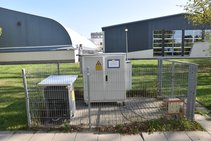Instrument
Raman-polarization-water-vapour PollyNeXT Lidar at the EARLINET Site in Warsaw (RS-Lab, since 2013)
lidar

Raman-polarization-water-vapour PollyNeXT Lidar at the EARLINET Site in Warsaw (RS-Lab, since 2013)
lidar
| Laboratory: | Remote Sensing Laboratory |
| Localisation: | ul. Pasteura 5 |
| Institute: | IG |
| Department: | APD |
| Head of the laboratory: | dr hab. Iwona S. Stachlewska |
The main, integral unit of the PollyXT-UW lidar is the far-range unit. Conduct the ground-based, zenith-aiming, quasi-continuous 24/7 measurements to provide so-called 3β+2α+2δ+WV set of optical properties profiles. The PollyXT-UW lidar is equipped with the Nd:Yag laser, emitting laser pulses of 180, 110, 60 mJ at 1064, 532, 355 nm, respectively, with the repetition rate of 20 Hz. The laser beams are expanded and sent coaxially into the atmosphere (the beam diameter at the output mirror is of 45 mm and the beam divergence is of 0.2 mrad). The signal receiver consists of a Newtonian telescope with a 300 mm primary mirror and 0.9 mm pinhole, resulting in the field of view of 1 mrad. The signal detection is performed in 8 channels: the elastic backscattered radiation is detected at 355, 532, 1064 nm, for the UV and VIS also elastic cross-polarized scattering and non-elastic vibrational Raman scattering on atmospheric N2 is measured (355s, 532s and 387, 607 nm, respectively). Additionally, for the UV, vibrational Raman scattering on H2O is recorded at 407 nm. For all channels, a photon-counting detection is used with Hamamatsu H10721P-110 photomultipliers (dead time of ~2 ns), except for the 1064 nm wavelength where an extra-cooled Hamamatsu R3236 photomultiplier is used. The signals are recorded with a 7.5 m height resolution up to an altitude of 48 km using the 600 MHz counters.
Instrument PIs: Dominika Szczepanik UW / Iwona Stachlewska UW
| dr hab. Iwona S. Stachlewska | Head of the laboratory |
